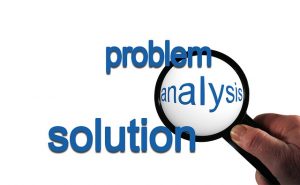Is the Pain from a Nerve Pinched, Doc?
I was recently asked this question from a patient who was experiencing pain that started in the back and wrapped around to the front of his left leg. It was super painful, but more importantly, it was preventing him from playing golf, something he loved to do. He was very worried that he would need to have surgery and ultimately that he wouldn’t be able to do the things he loved anymore, including golf.
He told me that the issue started when he bent down to pick something up off the floor — even though it really wasn’t that heavy.
It’s a Crime!
 I told the patient I was going to approach his health problem like it was a crime scene. That there is a health issue and it is our job to figure out what it is and what caused it. I also told him that I doubted that his problem started with picking up the object off the floor. That it probably started a long time before that moment.
I told the patient I was going to approach his health problem like it was a crime scene. That there is a health issue and it is our job to figure out what it is and what caused it. I also told him that I doubted that his problem started with picking up the object off the floor. That it probably started a long time before that moment.
Imagine if a person was shot and killed and the shooter dropped the gun and ran off. Then a few minutes later, someone came by and picked up the gun to move it away from the person who was shot. If that is when you came upon the scene, you would most likely deduce that this second person shot the victim and used the gun you see in his hand to do so. Of course, you would be wrong! But it makes sense that you would think this.
This is not uncommon for people to assume that the event that seemingly caused the pain was the event that caused the problem. Sometimes this would be correct. If I fall out of a tree, land on my back and fracture a vertebra, this is probably the reason for my pain.
The problem in many cases though is if the health practitioner just looks at where the pain is, the assumption will be made that the person holding the gun is the shooter. Without digging deeper, the root cause will be missed!
The History is Key!
Many of us grew up reading Encyclopedia Brown books. If you remember the books, Encyclopedia Brown was a young middle-school-aged boy who would solve the case just by hearing the story. You see: the most important part of an investigation is the history. The same is true for most health issues.
 As I dug deeper into his history, it turned out that the gentleman had fallen on ice about a year and a half ago. When he fell on the ice, he hurt his shoulder and the right side of his low back. He noticed some pain initially but then it seemed to go away on its own. He figured it healed itself.
As I dug deeper into his history, it turned out that the gentleman had fallen on ice about a year and a half ago. When he fell on the ice, he hurt his shoulder and the right side of his low back. He noticed some pain initially but then it seemed to go away on its own. He figured it healed itself.
The history revealed a trauma that seemed to heal itself. What may have happened though was a compensation pattern. We really don’t like pain and it is amazing how good we are at avoiding it. To avoid pain, we will shift our weight or not fully use that body part. This puts more wear and tear on the body part that must compensate.
The cause and true problem may have been revealed.
Now, to gather the evidence!
Look at the Evidence
The second most important part of a case is the evidence. In health care, it is the exam. It must be thorough, and it must look beyond the symptoms.
When I looked at patient’s posture, it was very evident that his right leg was significantly shorter than his left. The muscles in his low back were much tighter on the right and when I pushed on them, it caused pain on the left side of his leg just like the pain he had been having.
The conclusion was that when he had fallen on the right side, it caused pain. He compensated by shortening the muscles on the right side of his back to relieve the pain and he shifted his weight over to the left side of pelvis. Again, to relieve the pain. His pain (or at least the cause of the pain) had not gone away, he had just found a way to compensate so he would not have any more pain.
This is a pattern that we see all too many times.
Crime Solved
The great news is that we addressed the actual cause of his problem. In order to fix the problem, we addressed the initial injury to the right side of the body. We also needed to work on the compensation pattern that was created.
By taking the time to listen to the story and collect all the evidence, we got him back to feeling better and to playing golf.
No surgery necessary and no pinched nerve… just a pain referral pattern that went away once the underlying problem was solved.
What would have happened if we just focused on where the patient told us the pain was and we didn’t learn about the initial injury? What would have happened long term if the initial injury was never fixed?
Unfortunately, we see this all too often and it usually leads to a problem that becomes chronic or much more severe.
Taking the time to do a good history, a thorough exam to find the true cause, allowed us to solve the case. An innocent person was not found guilty.
We Need Better Investigators
The research shows that most people who have a back problem have a cause, yet most practitioners never find the cause and attribute the pain to psychological reasons.
It also shows that most doctors do not spend more than just a few minutes with most back-pain patients.
How can they figure out what is wrong? How come they don’t spend more time determining the cause?
The answers to these questions are poor training and insurance-based protocols that limit time with the patient and tell the doctor that most back pain (85%) is of unknown etiology (cause).
The Real Crime
While back pain is not the most glamorous thing to talk about, statistics show that it is one of biggest health issues in America.
- Back pain is the leading cause of disability in America
- It is one of the most common reasons Americans miss work
- Experts estimate that up to 80% of the population will experience back pain at some time in their lives
- Back pain is the third most common reason for visits to the doctor’s office, behind skin disorders and osteoarthritis/joint disorders
- Worldwide, years lived with disability caused by low back pain have increased by 54% between 1990 and 2015
- Low-back pain costs Americans at least $50 billion in health care costs each year—add in lost wages and decreased productivity and that figure easily rises to more than $100 billion
These statistics not only show that many people have back pain, but it is increasing.
Until we realize that most back issues do have a cause and are not just psychological, we will continue to see poor outcomes for so many with back pain.
The Usual Suspects
In the 1995 critically acclaimed movie “The Usual Suspects”, a serious crime is committed. This sparks the police to round up a group of criminals who most likely did the deed.
The problem though is the focus of the police is so tunnel vision on the “usual suspects” that they miss who the real criminal is even though he was right under their noses the entire time.
This same thing happens so often in health care, especially with back pain.
For sure there are common causes to low back pain and many low back patients have pain for those reasons but there are times that there are “unusual” causes.
For people to get help though, we must understand that 85% of all back pain is not due to an unknown etiology. We must do a better job.
Below are the most common causes of low back pain
- Sprain of a ligament
- Strain of a muscle
- Disc tear
- Spondylolisthesis. Normal wear and tear makes it hard for your joints and ligaments to keep your spine in the proper position, especially as we age. When a vertebra moves more than it should, it can slide forward and on top of another. When this happens, bones can press on the spinal nerves and cause lower back pain.
- Vertebral fractures caused by osteoporosis (brittle bones)
- Spinal stenosis. A narrowing of the spine space around the spinal cord can put pressure on nerves. The narrowing is typically caused by bone spurs that have developed as a result of osteoarthritis.
- Scoliosis. An abnormal curvature of the spine can cause back pain
- Sciatica
- Degenerative Joint Disease
- Subluxations or misalignments of the spine
Most of us are aware of these commons to some degree. The difficulty can be determining which of these common problems are causing your pain.
The Unusual Suspects
Aside from it being difficult to determine which of the usual causes of low back pain it may be, there are also unusual causes of low back pain that need to be investigated.
Below is a list of unusual causes. It is important to recognize that while they are unusual, they are not uncommon.
- Weak cerebellum on one side. The cerebellum coordinates balance and movement. If one side of the cerebellum is weak, it can lead to under-firing of muscles or balance issues on that same side.
- Poor frontal lobe control. The back of the frontal lobe has a strip called the motor strip, which causes movement of different body parts. If it is not firing properly, this can lead to poor movement.
- Poor parietal lobe control. The parietal lobe receives sensory information from the body. Poor interpretation of these senses will lead to poor joint movements.
- GAD antibodies leading to stiff man complex. The enzyme GAD converts the excitatory transmitter glutamate into GABA. This allows muscle to relax. If the enzyme is destroyed, then the muscles cannot relax.
- Fibromyalgia
- Autoimmune diseases
- Rheumatoid arthritis
- Scleroderma
- Psoriatic arthritis
- Food sensitivities
- Leaky gut
- Autoimmunity
- Systemic inflammation
- Referred pain from an organ
- Prostate
- Kidney
- Lung embolism
- Aorta dissection
Complex, Not Impossible
While this can feel very overwhelming and complicated, there is hope.
Finding the right investigator (doctor) will make all the difference in the world.
At Valeo, we believe that focusing on the patient, completing a thorough history and exam, examining all the evidence and being thoroughly trained in understanding both the usual suspects and the unusual suspects, allows us to be able to help people where others cannot.
Take Action
Having a health issue can be scary. It can be even more scary when you have been to multiple healthcare providers and no one can solve your problem.
We encourage you to take action, to seek out a provider who will spend the time to solve your case. We would love the opportunity to be able to help you. If you’d like to schedule an appointment, call our office at 952-949-0676.




